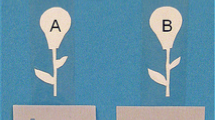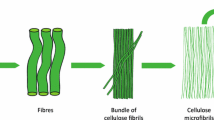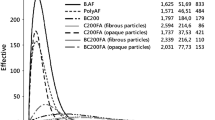Abstract
Bionanocomposites of hydroxypropyl cellulose (HPC) and nanofibrillated cellulose (NFC) were prepared by solution casting. The various NFC were in form of powders and were prepared from refined, bleached beech pulp (RBP) by mechanical disintegration, optionally combined with a pre- or post mechanical carboxymethylation. Dynamic mechanical analysis (DMA) and tensile tests were performed to compare the reinforcing effects of the NFC powders to those of their never-dried analogues. For unmodified NFC powders an inferior reinforcing potential in HPC was observed that was ascribed to severe hornification and reagglomeration of NFC. In contrast, the composites with carboxymethylated NFC showed similar behaviors, regardless of the NFC suspensions being dried or not prior to composite preparation. SEM characterization confirmed a homogeneous dispersion of dried, carboxymethylated NFC within the HPC matrix. These results clearly demonstrate that drying of carboxymethylated NFC to a powder does not decrease its reinforcing potential in (bio)nanocomposites.





Similar content being viewed by others
References
Alemdar A, Osman K, Sain M (2009) The effect of decreased fiber size in wheat straw/polyvinyl alcohol composites. J Biobased Mat Bioenerg 3:75–80
Aspler JS, Gray DG (1982) Interaction of organic vapours with hydroxypropyl cellulose. Polymer 23:43–46
Azizi Samir MAS, Alloin F, Paillet M, Dufresne A (2004) Tangling effect in fibrillated cellulose reinforced nanocomposites. Macromolecules 37:4313–4316
Azizi Samir MAS, Alloin F, Dufresne A (2005) Review of recent research into cellulosic whiskers, their properties and their application in nanocomposite field. Biomacromolecules 6:612–626
Bahia HS (1995) Treatment of cellulose. Patent publication number WO9515342
Bordeanu N, Eyholzer Ch, Zimmermann T (2008) Cellulose nanostructures with tailored functionalities. Pending patent
Cantiani R, Guerin G, Senechal A, Vincent I, Benchimol J (2001) Patent publication numbers US6224663, US6231657, US6306207
Cash MJ, Chan AN, Conner HT, Cowan PJ, Gelman RA, Lusvardi KM, Thompson SA, Tise FP (2003) Derivatized microfibrillar polysaccharide. Patent publication number WO0047628
Charlet G, Gray DG (1987) Solid cholesteric films cast from aqueous (hydroxypropyl)cellulose. Macromolecules 20:33–38
Couderc S, Ducloux O, Kim BJ, Someya T (2009) A mechanical switch device made of a polyimide-coated microfibrillated cellulose sheet. J Micromech Microeng 19:055006
Dalmas F, Cavaillé JY, Gauthier C, Chazeau L, Dendievel R (2007) Viscoelastic behaviour and electrical properties of flexible nanofiber filled polymer nanocomposites. Influence of processing conditions. Comp Sci Technol 67:829–839
Dinand E, Chanzy H, Vignon M, Maureaux A, Vincent I (1996) Microfibrillated cellulose and method for preparing same from primary wall plant pulp, particularly sugar beet pulp. Patent publication number WO9624720
Dufresne A, Vignon MR (1998) Improvement of starch film performances using cellulose microfibrils. Macromolecules 31:2693–2696
Excoffier G, Vignon M, Benchimol J, Vincent I, Hannuksela T, Chauve V (1999) Parenchyma cellulose substituted with carboxyalkyl groups and preparation method. Patent publication number WO9938892
Eyholzer Ch, Bordeanu N, Lopez-Suevos F, Rentsch D, Zimmermann T, Oksmann K (2010) Preparation and characterization of water-redispersible nanofibrillated cellulose in powder form. Cellulose 17:19–30
Gray DG (1983) Liquid crystalline cellulose derivatives. J Appl Polym Sci Appl Polym Symp 37:179–192
Herrick FW (1984) Process for preparing microfibrillated cellulose. Patent publication number US4481077
Herrick FW, Casebier RL, Hamilton JK, Sandberg KR (1983) Microfibrillated cellulose: morphology and accessibility. J Appl Polym Sci Appl Polym Symp 37:797–813
Horio M, Kamei E, Matsunobu K (1988) Dynamic measurements on polymer liquid crystals II. Thermotropic mesophase of hydroxypropyl cellulose. J Soc Rheol Jpn 16:27–32
Hubbe MA, Rojas OJ, Lucia LA, Sain M (2008) Cellulosic nanocomposites: a review. Biores 3:929–980
Hult EL, Larsson PT, Iversen T (2001) Cellulose fibril aggregation—an inherent property of kraft pulps. Polymer 42:3309–3314
Johnson RK, Zink-Sharp A, Renneckar SC, Glasser WG (2009) A new bio-based nanocomposite: fibrillated TEMPO-oxidized celluloses in hydroxypropylcellulose matrix. Cellulose 16:227–238
Jonoobi M, Harun J, Mathew A, Hussein M, Oksmann K (2009) Preparation of cellulose nanofibers with hydrophobic surface characteristics. Cellulose. doi: 10.1007/s10570-009-9387-9
Laivins GV, Scallan AM (1993) The mechanism of hornification of wood pulps. In: Proceedings of the 10th fundamental research symposium, Oxford, 1235–1260
Lindström T, Carlsson G (1982) The effect of carboxyl groups and their ionic form during drying on the hornification of cellulose fibers. Svensk Papperstidning 85:R146–R151
Lopez-Suevos F, Eyholzer Ch, Bordeanu N, Richter K (2010) DMA analysis and wood bonding of PVAc latex reinforced with cellulose nanofibrils. Cellulose 17:387–398
Nakagaito AN, Yano H (2005) Novel high-strength biocomposites based on microfibrillated cellulose having nano-order-unit web-like network structure. Appl Phys A 80:155–159
Pääkkö M, Ankerfors M, Kosonen H, Nykänen A, Ahola S, Österberg M, Ruokolainen J, Laine J, Larsson PT, Ikkala O, Lindström T (2007) Enzymatic hydrolysis combined with mechanical shearing and high-pressure homogenization for nanoscale cellulose fibrils and strong gels. Biomacromolecules 8:1934–1941
Pizzoli M, Scandola M, Ceccorulli G (1991) Dielectrical and mechanical loss processes in hydroxypropylcellulose. Plast Rubber Comp Process Appl 16:239–244
Rials TG, Glasser WG (1988) Thermal and dynamic mechanical properties of hydroxypropyl cellulose films. J Appl Polym Sci 36:749–758
Saito T, Nishiyama Y, Putaux JL, Vignon M, Isogai A (2006) Homogeneous suspensions of individualized microfibrils from TEMPO-catalyzed oxidation of native cellulose. Biomacromolecules 7:1687–1691
Scallan AM, Tigerström AC (1992) Swelling and elasticity of the cell walls of pulp fibers. J Pulp Pap Sci 18:188–193
Seydibeyoğlu MO, Oksman K (2008) Novel nanocomposites based on polyurethane and micro fibrillated cellulose. Comp Sci Technol 68:908–914
Shimamura K, White JL, Fellers JF (1981) Hydroxypropylcellulose, a thermotropic liquid crystal: characteristics and structure development in continuous extrusion and melt spinning. J Appl Polym Sci 26:2165–2180
Suto S, White JL, Fellers JF (1982) A comparative study of the thermotropic mesomorphic tendencies and rheological characteristics of three cellulose derivatives: ethylene and propylene oxide esters and an acetate butyrate ester. Rheol Acta 21:62–71
Suto S, Kudo M, Karasawa M (1986) Static tensile and dynamic mechanical properties of hydroxypropylcellulose films prepared under various conditions. J Appl Polym Sci 31:1327–1341
Turbak AF, Snyder FW, Sandberg KR (1983) Microfibrillated cellulose, a new cellulose product: properties, uses, and commercial potential. J Appl Polym Sci Appl Polym Symp 37:815–823
Wågberg L, Winter L, Ödberg L, Lindström T (1987) On the charge stoichiometry upon adsorption of a cationic polyelectrolyte on cellulosic materials. Colloid Surf 27:163–173
Wågberg L, Decher G, Norgren M, Lindström T, Ankerfors M, Axns K (2008) The build-up of polyelectrolyte multilayers of microfibrillated cellulose and cationic polyelectrolytes. Langmuir 24:784–795
Werbowyi RS, Gray DG (1980) Ordered phase formation in concentrated hydroxypropylcellulose solutions. Macromolecules 13:69–73
Werbowyj RS, Gray DG (1976) Liquid crystalline structure in aqueous hydroxypropyl cellulose solutions. Mol Cryst Liq Cryst 34(Letters): 97–103
Wojciechowski P (2000) Thermotropic mesomorphism of selected (2-hydroxypropyl) cellulose derivatives. J Appl Polym Sci 76:837–844
Yano H, Nakahara S (2004) Bio-composites produced from plant microfiber bundles with a nanometer unit web-like network. J Mater Sci 39:1635–1638
Young RA (1994) Comparison of the properties of chemical cellulose pulps. Cellulose 1:107–130
Zadorecki P, Michell AJ (1989) Future-prospects for wood cellulose as reinforcement in organic polymer composites. Polym Compos 10:69–77
Zimmermann T, Pöhler E, Geiger T (2004) Cellulose fibrils for polymer reinforcement. Adv Eng Mater 6:754–761
Acknowledgments
The authors gratefully acknowledge the State Secretariat for Education and Research (SER) for financial support of this work.
Author information
Authors and Affiliations
Corresponding author
Rights and permissions
About this article
Cite this article
Eyholzer, C., Lopez-Suevos, F., Tingaut, P. et al. Reinforcing effect of carboxymethylated nanofibrillated cellulose powder on hydroxypropyl cellulose. Cellulose 17, 793–802 (2010). https://doi.org/10.1007/s10570-010-9423-9
Received:
Accepted:
Published:
Issue Date:
DOI: https://doi.org/10.1007/s10570-010-9423-9




